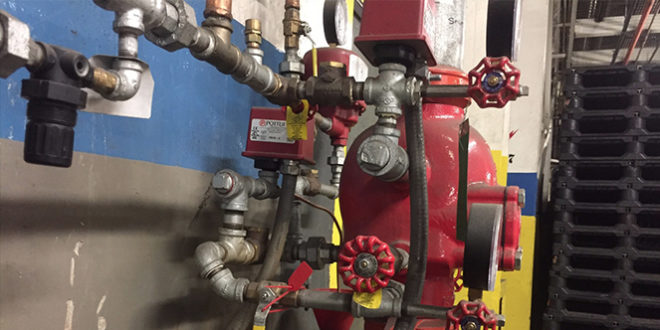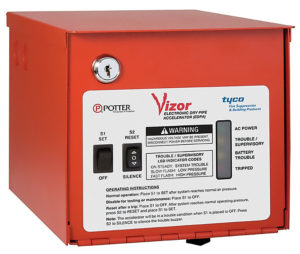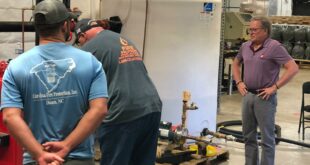
Quick-Opening Devices
How You Can Make a Difference with ITM
How many times have you shown up to a facility for a dry-pipe valve inspection or test, and entered the riser room only to find the water and air normal, but the valve supplying air to the quick-opening device closed? It happens more often than you would think.
Does this mean the valve won’t open? No, but it may not operate as designed or how NFPA 13, Standard for the Installation of Sprinkler Systems, (2016 edition) intended. Many dry-pipe valves have traditionally been designed as differential-pressure valves. This means the clapper has a surface area on the air side which is greater than that on the water side. The difference between these areas determines the differential (i.e., 6:1, 5:1). Those differentials will vary based on the manufacturer and model.
Table 7.2.3.6.1 in the 2016 edition of NFPA 13 states water delivery requirements for dry-pipe systems based on hazard. The larger a system gets, the less chance there is of fulfilling the water delivery requirements. For this reason it is beneficial, and sometimes necessary, to add a quick-opening device to the valve set. The quick-opening device recognizes air pressure loss and is designed to operate before the traditional dry-pipe valve drops below its differential trip pressure. This allows the valve to operate much quicker than it would if there was no quick-opening device, thus helping the NFPA 13 water delivery requirements to be met.
Unfortunately, it is not uncommon for a quick-opening device to be installed, pass the initial acceptance test, and then be neglected. The 2017 edition of NFPA 25, Standard for Inspections, Testing, and Maintenance of Water-Based Fire Protection, requires dry-pipe valves to be annually trip tested with a partial trip and fully tripped every third year. Once this testing is completed, the quick-opening device is expected to be in service; however, these devices are often misunderstood and may also be difficult to reset back into service. As a result, they are frequently shut off from the air supply and left out of service for months, if not years, at a time.

Additionally, many contractors, property owners, and maintenance personnel do not realize that quick-opening devices are required to be tested quarterly, per section 13.4.5.2.4 of the 2017 edition of NFPA 25. Testing procedures for quick-opening devices should be in accordance to the manufacturer instructions found in the technical documentation. This is normally a relatively easy test procedure that can be done by a trained, qualified individual in a very short period of time. These quick-opening device tests typically require shutting off the water supply to ensure there is not a false trip of the system. At the completion of the quick-opening device test, a valve status test (also referred to as a “main drain”) is required to verify that the system control valve is not closed.
An out-of-service, quick-opening device can be detrimental to the entire fire protection system, leaving a portion, or all, of the building with inadequate protection. There are quick-opening devices, called electronic accelerators, designed to operate in under four seconds of initial activation of a sprinkler. This means that within four seconds of a sprinkler activating from the heat of a fire, the dry valve opens, allowing water to flow to the fire area. In the exact same type of system where a quick-opening device is left out of service, it could take upwards of two to four minutes, or longer, before the valve reaches its trip point to allow water to flow into the system. Volume of pipe in the system is one factor that can significantly impact water delivery time. A large volume of pipe means a greater volume of air and, therefore, more time for the air to release and the valve to trip. A longer delay in valve trip and water delivery time means the fire has much more time to grow without any water being discharged, resulting in the activation of additional sprinklers which could overwhelm the water supply and leave the building with inadequate fire sprinkler protection.
The simple steps of inspecting and testing an installed quick-opening device could mean the difference between a contained fire with just a few sprinklers operating and the complete loss of a building due to delayed activation of a system.
ABOUT THE AUTHOR: Devin O’Leary is manager of technical training for Johnson Controls at the Frederick Grinnell Education Center, Cranston, Rhode Island.

 Sprinkler Age A Publication of the American Fire Sprinkler Association
Sprinkler Age A Publication of the American Fire Sprinkler Association
